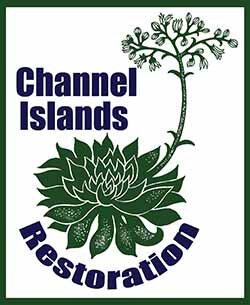Developing a Chumash Ethnobotanical Nature Trail at the San Marcos Foothills Preserve
Article by Doug Morgan, CIR Operations Manager
Volunteers in action at the San Marcos Foothills Preserve
Regular visitors to the West Mesa at the San Marcos Foothills Preserve (SMFP) may have noticed changes in our developing Chumash Ethno-Botanical Nature Trail. It is also getting more foot traffic as people appreciate the beautiful 360-degree views and gentle rise in elevation. This is due to the talented design of the trail builder, Ray Ford. A good trail maximizes the surrounding beauty and minimizes the effort and maintenance. It’s a perfect stroll for those who like to savor each step, and moderate use is precisely what a trail needs to stay in good shape. This trail was designed to be slowly savored, but we are far from done.
We enlisted the help of Chumash people, local experts in a variety of disciplines, and our in-house staff to create an interpretive garden to educate visitors on the history, culture, ecology, and especially the uses and value of the native plants that were once common on the West Mesa and surrounding areas. We have a beautiful design, an extensive plant pallet, and several thousand plants growing in our greenhouse, and we have begun tentatively installing a few natives to get some momentum on the project. All plants for the trail were grown from seed collected at the SMFP.
Purple Needle Grass (Stipa pulchra)
Right after the trail was constructed, we began quietly planting Purple Needle Grass (Stipa pulchra). As regular readers may remember, this is a critical foundation plant that helps amend the soil, brings up moisture from deep underground, and limits erosion very well (for those of you who don’t remember that last point, please join one of our seed collection events; you will walk away with more Stipa knowledge than is socially acceptable outside of our restoration world). If you know what to look for, you will see hundreds are growing quite nicely around the trails and especially in the retired social trail footprints. Most people miss them entirely. Because we wanted people to notice and use the trail as it evolves, we also added some California sagebrush (Artemisia Californica) because everyone likes that plant. Only the most observant people noticed that there were a few scattered plants in a big area. Around that time, I only saw very few footprints of a few people on the trail.
Developing Chumash Ethno-Botanical Nature Trail.
We secured the funding to continue our prescribed grazing program. Hence, we installed sheep exclusion baskets over the Artemisia. Still, the site could benefit from a few more years of grazing, especially now that the lack of rain has delayed planting until at least the fall of 2025. We wanted the baskets to be big enough so that when we finally remove them, we don’t have to trim many Artemisia branches to get the basket off. We also tested the soil and began to understand just how harsh that area is to grow hot, full sun, poor soil nutrients, and a near lack of organic material in the adobe clay soil, so there are few bugs, grubs, and worms (and most likely few desirable microscopic friends to plants too). We decided to add mulch to the organic material, retain moisture, provide weed control, and help define the trail. Mulch and fertilizer quickly reverse the poor soil condition, and the installed native plants thrive with considerably less additional water needed. This immediately increased trail traffic and awareness. We installed bigger temporary sheep exclusion baskets and added fabric to the cages to provide a small amount of shade and, as we learned on the islands, capture airborne moisture. This seems to be helping, as currently, those installed Artemesia are some of the only green and thriving plants out there this dry year.
So, what’s next?
We will continue to add mulch. We are planning an emergency temporary irrigation system in case next season is also dry. We will continue to stockpile native plants from local seed to plant next fall. We will continue to seek funding to allow this project to be sustainable for many years.




